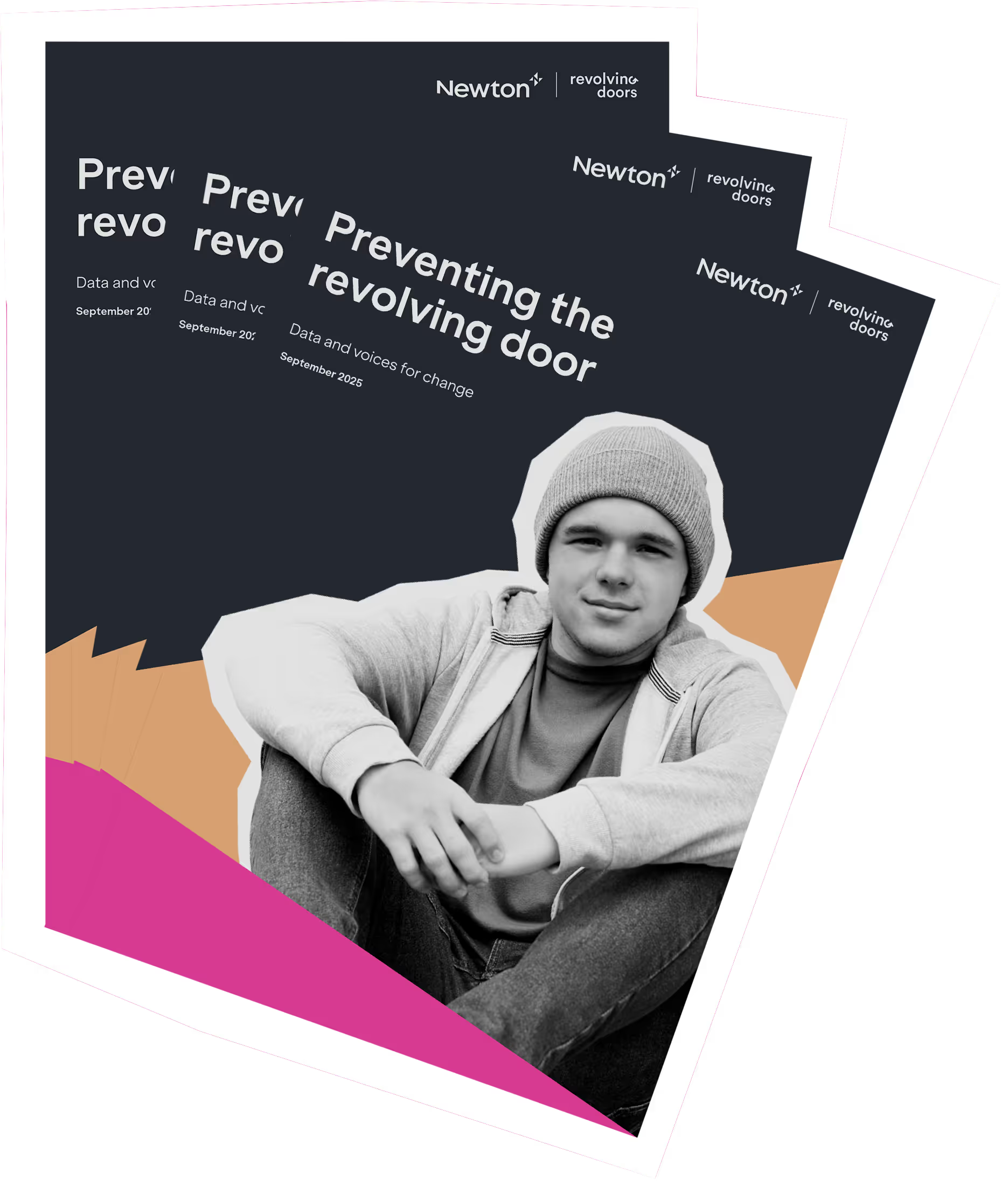Quantitative findings
Advanced analysis reveals the patterns, unmet needs, and risks driving the revolving door cohort, showing how data can inform smarter, preventative interventions.


Key findings:
using the quantitative data
The quantitative research used advanced analytics and AI to bring together data from multiple services, creating a single, comprehensive view of individuals caught in repeat offending. By combining structured records with the rich detail in case notes, this research uncovered the true scale and complexity of unmet needs - insights often missed by traditional approaches.
in England and Wales meet the definition of the revolving door cohort.
behavioural challenges, problematic substance use & mental health needs
of both prolific shoplifters and violent offenders experience behavioural issues and substance use challenges.
committed by this cohort, driven by overlapping unmet needs
violent crimes are associated with a higher number of unmet needs; all offenders in both groups have at least one recorded unmet need.
the number of offences is directly linked to the number of recorded vulnerabilities.
most common combination of unmet needs

Understanding the data
To map the revolving door cohort, multiple data sources were combined and analysed. Patterns from the qualitative interviews, including archetypes like prolific shoplifters and violent offenders were translated into journey maps across public services.
These journeys were overlaid with the full range of unmet needs identified in interviews and matched against an integrated dataset covering criminal justice, welfare, social care, housing, education, and family. This approach made it possible to quantify the scale, prevalence, and impact of these patterns on public services.


Unmet needs
Based on the interviews and Revolving Doors’ previous research, unmet needs appear to influence offending and repeat contact with the justice system.
This analysis examined the data to confirm these patterns and to quantify how widespread and impactful these unmet needs are.
Finding 1: A higher number of offences is associated with a higher number of recorded unmet needs.
There is a clear link between the number of unmet needs and the number of offences committed by the revolving door cohort, including shoplifting, drug offences, assault on emergency workers, criminal damage, and ABH/GBH. Offenders with more offences tend to have a higher proportion of recorded unmet needs, reflecting both increased recording and escalating levels of need. Qualitative research suggests violent offences often emerge as needs remain unmet, with patterns of offending intensifying alongside worsening circumstances.
The data reflects what interviewees described: many struggled with substance use, mental health, or trauma before coming into contact with the justice system. This evidences their lived experience and shows a clear link between unmet needs and repeat offending.
Focusing on prolific offenders (2,415 people with 10+ offences in two years) highlights the scale of this challenge. At least one unmet need was recorded for 1,925 of them, most commonly mental ill health, substance use, and unstable housing. Nearly 60% had more than two unmet needs, underlining the importance of systemic, person-centred support to break the cycle of reoffending.
Finding 2: The three most prevalent unmet needs are behavioural, problematic substance use and mental health.
Analysis of the prolific offender cohort shows that behavioural needs, problematic substance use, and mental health challenges are the three most prevalent unmet needs.
For those with three or more unmet needs (31% of the cohort), these three risks overlap repeatedly - mirroring what people said in the interviews about the challenges driving repeat offending.
Other factors, like neurodiversity and financial struggles, are harder to spot in the data but remain important. With better reporting, these hidden needs could be surfaced more clearly and addressed earlier.
Finding 3: Behavioural challenges dominate
97% of prolific offenders in the data have behavioural issues flagged, with 78% showing aggression in their case notes.
The most common unmet need combination is:
- Behavioural issues
- Problematic substance use
- Discrimination
More than half of individuals with exactly three unmet needs share this pattern, closely reflecting the stories told in interviews.
With richer and more consistent data over time, these combinations can be tracked in greater detail — strengthening the evidence base and showing how different factors interact to drive repeat offending.
Patterns of offending
Unmet needs help explain why people get caught in the revolving door, but the type and pattern of offences and adds another layer of insight.
One clear example is shoplifting. Of the 1,905 individuals who shoplifted as their second offence, 1,236 went on to offend again — and 1,100 of those repeated the same offence.
This shows how offending behaviour often becomes entrenched and cyclical, with people repeatedly drawn back into the system. Identifying these patterns provides a clearer view of escalation and highlights where earlier, more tailored interventions could make the biggest difference.
Finding 1: Prolific shoplifting archetype
The data shows that shoplifting is often the entry point into the revolving door of repeat offending. In the reference data, 10% of first recorded offences was shoplifting (5,256 cases).
When individuals reoffended after shoplifting, the majority committed the same offence again. While some went on to more serious crimes - such as ABH, GBH, or drug offences - most remained caught in a cycle of repeat shoplifting.
This creates a clear prolific shoplifting archetype, where minor offences become entrenched patterns of behaviour that can persist without effective intervention.
Finding 2: Prolific ABH archetype
To a lesser extent, there is a similar pattern with ABH, defining a prolific violence archetype.
The qualitative research showed that ABH offences were often linked to unmet mental health needs and substance use.
Finding 3: Drug Offences
The data does not suggest a distinct cohort of prolific drug offenders. Interviewees explained this reflects reality: drugs are often purchased and consumed quickly, meaning users are less likely to be caught in possession - but more likely to be caught shoplifting to fund their use.
Addiction drives erratic and unpredictable behaviour, which is reflected in the data as a lack of consistent offence patterns. Rather than a clear, organised cycle, offending linked to drug use is often chaotic and varied.
Recognising these patterns is critical. It helps build a clearer picture of subgroups within the revolving door cohort, and in turn supports setting thresholds so public services can deliver more targeted, proportionate interventions.
Useful links

Findings from 20 in-depth interviews with people who have lived through the revolving door of crisis and crime.

Research revealed clear patterns in the lives of people caught in the revolving door of crime, reflected both in the 20 interviews and in service data.

Combining detailed reference data with local socio-economic information revealed how the size, shape, and needs of the revolving door cohort vary across England.
Read more about the research process, key findings, and expert recommendations.
